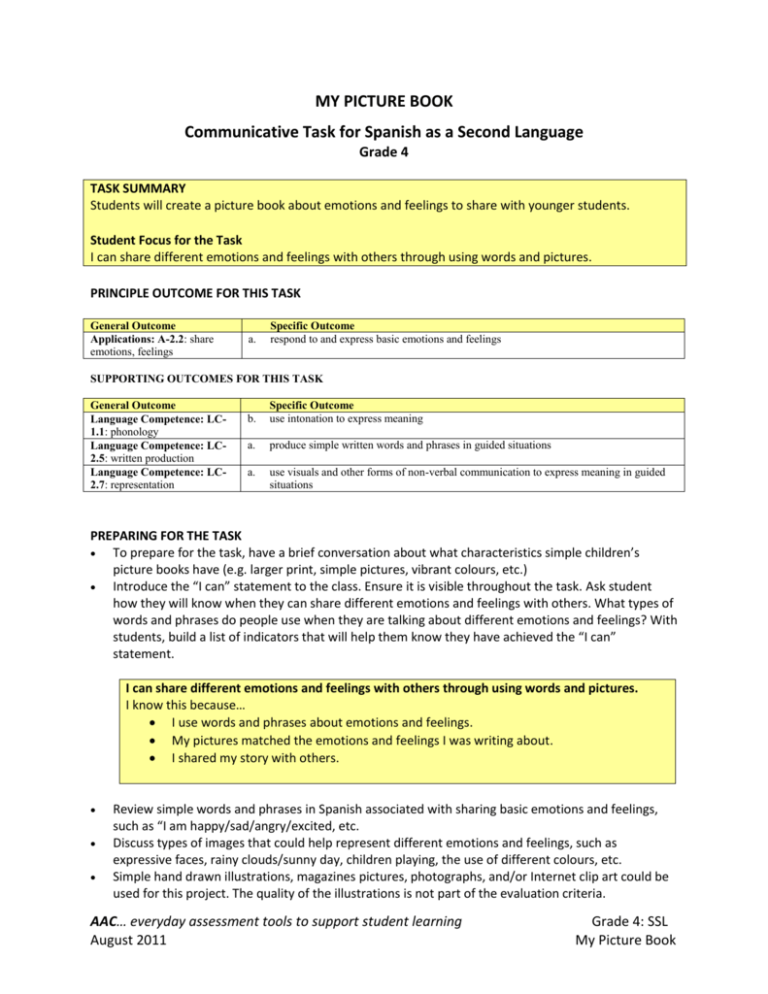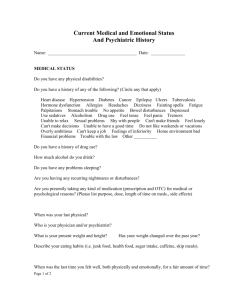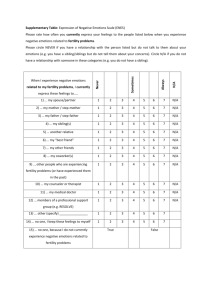My Picture Book - Alberta Assessment Consortium
advertisement

MY PICTURE BOOK Communicative Task for Spanish as a Second Language Grade 4 TASK SUMMARY Students will create a picture book about emotions and feelings to share with younger students. Student Focus for the Task I can share different emotions and feelings with others through using words and pictures. PRINCIPLE OUTCOME FOR THIS TASK General Outcome Applications: A-2.2: share emotions, feelings a. Specific Outcome respond to and express basic emotions and feelings SUPPORTING OUTCOMES FOR THIS TASK General Outcome Language Competence: LC1.1: phonology Language Competence: LC2.5: written production Language Competence: LC2.7: representation b. Specific Outcome use intonation to express meaning a. produce simple written words and phrases in guided situations a. use visuals and other forms of non-verbal communication to express meaning in guided situations PREPARING FOR THE TASK To prepare for the task, have a brief conversation about what characteristics simple children’s picture books have (e.g. larger print, simple pictures, vibrant colours, etc.) Introduce the “I can” statement to the class. Ensure it is visible throughout the task. Ask student how they will know when they can share different emotions and feelings with others. What types of words and phrases do people use when they are talking about different emotions and feelings? With students, build a list of indicators that will help them know they have achieved the “I can” statement. I can share different emotions and feelings with others through using words and pictures. I know this because… I use words and phrases about emotions and feelings. My pictures matched the emotions and feelings I was writing about. I shared my story with others. Review simple words and phrases in Spanish associated with sharing basic emotions and feelings, such as “I am happy/sad/angry/excited, etc. Discuss types of images that could help represent different emotions and feelings, such as expressive faces, rainy clouds/sunny day, children playing, the use of different colours, etc. Simple hand drawn illustrations, magazines pictures, photographs, and/or Internet clip art could be used for this project. The quality of the illustrations is not part of the evaluation criteria. AAC… everyday assessment tools to support student learning August 2011 Grade 4: SSL My Picture Book INSTRUCTIONAL SUPPORT Explain the task and allow students time to create a simple storyboard for their books. Students use words, phrases, colours, images, materials, etc. to create their storybooks. When reading their picture books aloud, encourage students to use intonation to help express the emotions/feelings depicted. Model appropriate intonation when reading. FEEDBACK FOR LEARNING Students complete a rough draft of their storybook, and give it to a classmate for feedback. Students practice reading their story aloud to a classmate using appropriate intonation. Their classmate can provide oral feedback as to the effectiveness of their intonation. For peer coaching, sentence prompts such as the following could be used: o When you were reading about (an emotion) I noticed that your voice (describe the use of the intonation). o I think it would be helpful to try… After reading to the younger students, students reflect on whether or not they were able to achieve the “I can” statement, by using the indicators. This task was developed by teachers at the Alberta Assessment Consortium (AAC) Summer Workshop for Second Languages, funded by a grant from Alberta Education. AAC… everyday assessment tools to support student learning August 2011 Grade 4: SSL My Picture Book MY PICTURE BOOK – Student Task As grade four Spanish students, you are going to visit and teach some Spanish to a group of younger students. You will be reading simple picture books that you will create. Your picture book will focus on emotions and feelings. On each page, illustrate an event that would cause you to express a particular emotion or feeling. For example, a birthday party could cause you to feel happy. Your picture book should include at least five situations, each representing a different emotion or feeling. Read your picture book to a younger student in Spanish. Use your tone of voice to help the younger student understand the picture book without using English. AAC… everyday assessment tools to support student learning August 2011 Grade 4: SSL My Picture Book







